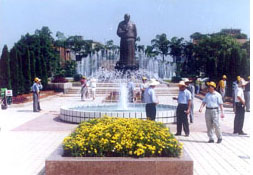www.lzx.chinaspirit.net.cn
 |
The Lin Zexu Memorial, located at Fuzhou of Fujian Province and founded in 1982 in memory of the national hero Lin Zexu of the Qing Dynasty (1644-1911), is a memorial of Chinese historical figure. The site of the memorial, covering an area of 3,000 square meters, used to be the memorial temple of Lin Zexu built in 1905. The main buildings inside the memorial are the Yimen Hall, YubeiPavilion, ShudeHall, the southern and northern reception rooms, QuchiBuilding and ZhubaiStudy. The memorial, built in the style of the gardens in Jiangnan (a region in the lower reaches of Yangtze River Valley, including southern Jiangsu and Anhui and northern Zhejiang), is one of the major historical sites under the protection of Fujian Province.
On the screen wall facing the gate of the memorial is a large relief sculpture ofBurning Opium at Humenand above the gate is a horizontal board inscribed withMemorial Hall of Revered Mr. Lin. On either side of the corridor are displayed over 20 boards inscribed with the official posts Lin Zexu once held. The YubeiPavilion is a square pavilion with three stone tablets bestowed by the emperors arranged in a triangle shape. The one in the middle is an imperial edict of condolences bestowed to Lin's dependents by Emperor Xianfeng (r.1831-1861) of the Qing Dynasty on learning about Lin's death, the left one is an elegiac article conferred by the emperor, and the right one is a stone tablet engraved with the emperor's handwriting. The ShudeHall is the main hall of the memorial with Lin Zexu's statue in official costume seated in the middle of the hall and a horizontal board inscribed with Happiness and Longevity written by Emperor Daoguang (r.1782-1852) of the Qing Dynasty above the statue. The QuchiBuilding has been turned into an exhibition hall. The Zhubaixuanis a two-storied pavilion of primitive simplicity. The space in the downstairs, capable of holding around 100 people, is now used as a small cinema for film shows and documentaries in coordination with the exhibition while the space in the upstairs is used as a reference room and reading room with books and historical relics collected open to the public for study.
The main purpose of the memorial is to reflect Lin Zexu's life story. The 120-odd exhibits include antithetical couplets, screens, fan coverings, letters, manuscripts and notes in Lin's own handwriting; and the things left behind him include the seals, ink sticks, and the red ink paste used for seals. The most precious relics are the manuscript of his finalized poems and theProperty Division Paperhandwritten by Lin Zexu's father Lin Binri. TheYazhai Zalu(Miscellaneous Notes of Office Work) is a collection of copies of Lin Zexu's official documents and archives during the period of his exile in Yili. It is a pity that quite a number of important documents and archives are already lost.